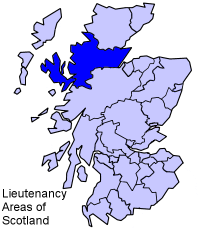
Ross and Cromarty, sometimes referred to as Ross-shire and Cromartyshire, is a variously defined area in the Highlands and Islands of Scotland. There is a registration county and a lieutenancy area in current use, the latter of which is 8,019 square kilometres in extent. Historically there has also been a constituency of the Parliament of the United Kingdom, a local government county, a district of the Highland local government region and a management area of the Highland Council. The local government county is now divided between two local government areas: the Highland area and Na h-Eileanan Siar. Ross and Cromarty border Sutherland to the north and Inverness-shire to the south.

Achnashellach railway station is a railway station serving Achnashellach on the Kyle of Lochalsh Line, in Wester Ross, Scotland. The station lies between Strathcarron station and the Glen Carron platform.

The Kyle of Lochalsh line is a primarily single-track railway line in the Scottish Highlands, from Dingwall to Kyle of Lochalsh. Many of the passengers are tourists, but there are also locals visiting Inverness for shopping, and commuters. All services are provided by ScotRail and run beyond Dingwall to Inverness. In the past there were some through services to and from Glasgow, Edinburgh or Aberdeen. None of the line is electrified, and all trains on the line are diesel-powered, as are all other trains in the Scottish Highlands.

Dingwall railway station serves Dingwall, Scotland. It is located just south of the junction of the Far North Line and the Kyle of Lochalsh Line, and is served by ScotRail. The station is 18 miles 58 chains (30.1 km) from Inverness, and is the zero point for the Kyle of Lochalsh Line. It is sited after Conon Bridge heading northbound, with the next station being either Garve or Alness.

Inverness railway station is the railway station serving the Scottish city of Inverness. It is the terminus of the Highland Main Line, the Aberdeen–Inverness line, the Kyle of Lochalsh line and the Far North Line.

Achanalt railway station is a geographically remote railway station on the Kyle of Lochalsh Line, serving the village of Achanalt in the north of Scotland.
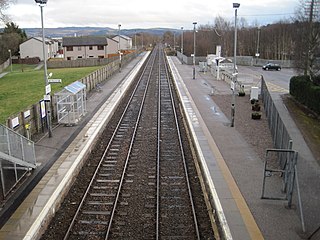
Muir of Ord railway station is a railway station on the Kyle of Lochalsh Line and the Far North Line, serving the village of Muir of Ord in the Highland council area of Scotland. The station is 13 miles 4 chains from Inverness, between Beauly and Conon Bridge, and is the location of the sole remaining passing loop on the single line between Dingwall and Inverness.

Garve railway station is a railway station on the Kyle of Lochalsh Line, serving the village of Garve in the north of Scotland. Garve is located at the eastern edge of Loch Garve. It was to be the junction for the Garve and Ullapool Railway, intended to connect Ullapool, the Western Isles' nearest mainland port, with the rest of the UK. An act of parliament was passed for the line in 1890, but in spite of local efforts in that year, and again two years later, the idea could not be fully financed and was abandoned.
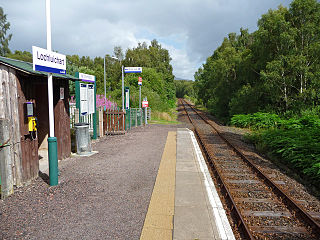
Lochluichart railway station is a railway station on the Kyle of Lochalsh Line, serving the village of Lochluichart in the north of Scotland. Lochluichart is located at the north edge of Loch Luichart

Achnasheen railway station is a remote railway station on the Kyle of Lochalsh Line, serving the village of Achnasheen in the north of Scotland.

Attadale railway station is a remote railway station on the Kyle of Lochalsh Line, serving the village of Attadale on Loch Carron in the Highlands, northern Scotland.

Stromeferry railway station is a station on the Kyle of Lochalsh Line, serving the village of Stromeferry in the Highlands, northern Scotland. Stromeferry lies on the southern shore of Loch Carron, across from the ruined Strome Castle, near the west coast. It is one of five mandatory calling points on the Kyle line, along with Plockton, Strathcarron, Achnasheen and Garve.
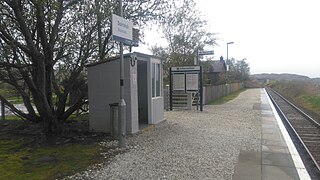
Duirinish railway station is a remote railway station on the Kyle of Lochalsh Line near the settlement of Duirinish in the Highlands, northern Scotland. Duirinish is 2 miles (3 km) inland of Scotland's west coast, near Loch Lundie.

Kyle of Lochalsh railway station is the terminus of the Kyle of Lochalsh Line in the village of Kyle of Lochalsh in the Highlands, northern Scotland.
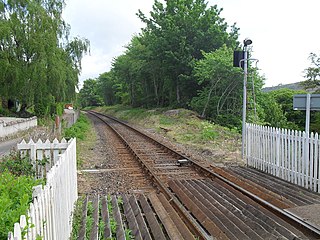
Achterneed railway station was a railway station serving Strathpeffer and located on the Kyle of Lochalsh Line, in Wester Ross, Scotland.

Conon Bridge is a railway station on the Far North and Kyle of Lochalsh Lines, which serves the villages of Conon Bridge and Maryburgh in the Scottish Highlands. Initially known as Conon, it originally closed in 1960 and reopened on 8 February 2013. The station is 16 miles 21 chains (26.2 km) from Inverness, between Muir of Ord and Dingwall.

Strathpeffer railway station was a railway station serving the town of Strathpeffer in the county of Ross and Cromarty,, Scotland. The first station was located some distance from the town, on the Dingwall and Skye Railway line, and was opened in 1870.
Murdoch Paterson was an engineer and architect based in Inverness, Scotland, who was chief engineer of the Highland Railway.

The Garve and Ullapool Railway was one of several branch railway-lines proposed for the North-West Highlands of Scotland, in the 1880s and 1890s. The project received approval from the Westminster Parliament by means of a Local Act of 14 August 1890. The line did not gain financial backing and was never constructed. Renewed attempts to build it were made in 1896, 1901, 1918 and 1945, again with no success.
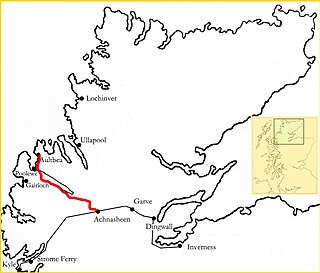
The Loch Maree and Aultbea Railway was one of several branch railway-lines proposed for the North-West Highlands of Scotland in the early 1890s. Although a full survey was conducted in 1892 and a Private Bill was submitted to the Westminster Parliament on 18 November 1892, the necessary Act to permit construction did not receive approval and the plan was dropped.



















